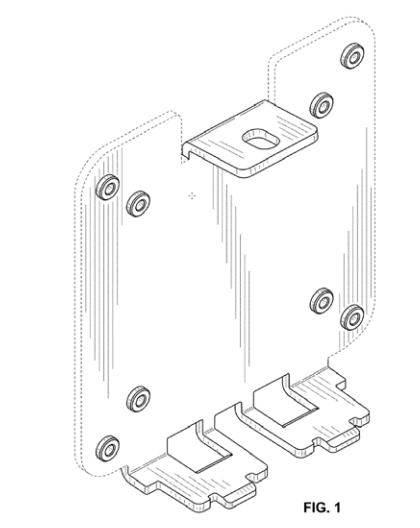On June 11, 2020, the Patent Trial and Appeal Board designated as precedential a decision regarding when agreements collateral to settlement must be disclosed under 35 U.S.C. §317(b). The Board also designated as informative three decisions: one instituting post-grant review of a design patent, one terminating a proceeding due to settlement without deciding the patent owner's motion to amend, and one providing guidance on the use of confidential information during an oral hearing. Precedential decisions are binding on all Board panels. Informative decisions are not binding, but they do provide Board norms on recurring issues, guidance on issues of first impression to the Board, guidance on Board rules and practices, and guidance on issues that may develop through analysis of recurring issues in many cases. Patent Trial and Appeal Board Standard Operating Procedure 2 (Rev. 10) at 9.
DTN, LLC v. Farms Tech., LLC, IPR2018-01412, IPR2018-01525, Paper 21 (June 14, 2019) (precedential)
In DTN v. Farms Tech., the Board found that, under 35 U.S.C. §317(b), parties seeking to terminate an inter partes review after settlement must file any collateral agreements referred to in the settlement agreement between the parties, regardless of whether the parties to the inter partes review differ from those to the collateral agreements.
After settling two inter partes reviews, the parties submitted joint motions to terminate the proceedings. As required by 35 U.S.C. §317(b), the parties filed their written Settlement Agreement. But the parties did not file two collateral agreements referred to in that Agreement. When directed by the Board to file the collateral agreements, the parties initially declined, arguing that §317(b) only requires the filing of agreements "between the patent owner and a petitioner"—and the collateral agreements were between the petitioner and a third party corporate entity affiliated with the patent owner, not the patent owner itself.
The Board disagreed, relying on the text of §317(b) that requires parties seeking settlement to file "[a]ny agreement...between the patent owner and a petitioner, including any collateral agreements referred to in such agreement..." The parties' Settlement Agreement undisputedly referred to the collateral agreements. That the patent owner was not a party to either of the collateral agreements did not matter; "the term 'any' means 'any,'" the Board found, and thus the parties were required to file the collateral agreements, too.
If the parties' proposed interpretation were adopted, the Board wrote, parties to post-grant proceedings could simply enter into short agreements between themselves, referencing "a separate agreement between one or more related but different corporate entities than the parties to the IPR proceeding, either controlling or controlled by the parties to the proceeding." That separate, collateral agreement would then be insulated from review by "Federal Government agencies on written request" or "any person on a showing of good cause" as allowed by 35 U.S.C. §317(b). The Board thus concluded that the collateral agreements fell within 35 U.S.C. §317(b), and that the parties must file them before the Board could terminate the inter partes reviews.
Sattler Tech. Corp. v. Humancentric Ventures, LLC, PGR2019-00030, Paper 9 (July 26, 2019) (informative)
Sattler Tech filed a petition for post-grant review of Humancentric's design patent, arguing that the challenged claim was unpatentable for lack of ornamentality. Humancentric's patent claimed the ornamental design for a "VESA mount adapter bracket," a perspective view of which is shown below:

In its petition, Sattler argued that VESA mount adapter brackets are specifically designed to fit onto the back of video monitors so that they can attach to monitor mount systems that use an industry standard, known as the Video Electronics Standards Association Flat Display Mounting Interface Standard. Several aspects of Humancentric's patented design were actually functional, not ornamental, Sattler argued, including the tabs at the top and bottom of the bracket and the grommets' placement, size, and raised edges. Each of these features, Sattler argued, is necessary to conform to the VESA standard. And all alternative VESA mount adapter brackets would have the same design or appearance as Humancentric's, Sattler asserted, because that design is necessary for it to function.
The Board found that Sattler had shown it was more likely than not that the challenged claim of Humancentric's patent was unpatentable for lack of ornamentality. Each of the individual elements of the design, the Board found, "appears to be dictated solely by function." In addition, the overall appearance of the bracket suggested it was not ornamental but rather functional. Thus, the Board instituted post-grant review of Humancentric's design patent.
Kokusai Electric Corp. v. ASM IP Holding B.V., IPR2018-01151, Paper 38 (Aug. 20, 2019) (informative)
After settling an inter partes review, the parties filed a joint motion to terminate. Before the motion to terminate was filed, however, the patent owner had filed a contingent motion to amend, and the petitioner had filed an opposition to that motion. The parties' motion to terminate requested that the Board grant-in-part the pending motion to amend, which they characterized as "now unopposed." Citing 35 U.S.C. §316(d)(2), which provides that the Board may decide a motion to amend to "materially advance the settlement of a proceeding," the parties argued that the Board had the authority to decide the motion to amend before terminating the proceeding.
The Board declined to rule on the "unopposed" motion to amend because it determined that ruling would not be an efficient use of resources. Neither the parties' settlement agreement nor their joint termination request was contingent on the motion to amend, so deciding on the patentability of the proposed claims would not "materially advance" settlement. Further, under 35 U.S.C. §317(a), proceedings must be terminated upon the parties' joint request, provided the Board has not yet made a decision on the merits. Deciding the patent owner's motion to amend would require determining the patentability of the proposed substitute claims, effectively rendering a decision on the merits—and thus possibly precluding termination of the proceeding under §317(a). The Board also questioned whether it had the authority to issue a certificate amending the claims in the absence of also rendering a final written decision.
In light of these concerns, the Board granted the parties' joint motion to terminate without reaching a decision on the patent owner's motion to amend. However, the Board did suggest that the patent owner could seek to amend its claims through reissue or reexamination.
Curt G. Joa, Inc. v. Fameccanica.Data S.P.A., IPR2016-00906, Paper 61 (June 20, 2017) (informative)
The patent owner requested that a portion of the Board's oral hearing be closed to the public to present confidential information, and the Board granted that request. A previous Board order had allotted 60 minutes to each side for oral argument. To accommodate the patent owner's request, the Board modified that previous order to allow each side to allocate up to, but not more than, fifteen minutes of closed argument, during which the courtroom would be closed to the public. Either party was given the option to allocate more time to the open portion of the hearing, but time not used during the open portion could not be reserved for use during the closed portion. Finally, no confidential information could be included in any demonstrative exhibit; rather, confidential information could be discussed during the closed portion by referencing the record.
Originally published 26 June, 2020
The content of this article is intended to provide a general guide to the subject matter. Specialist advice should be sought about your specific circumstances.

